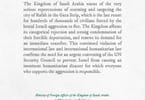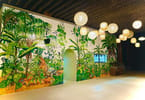The eyes of the world could soon be on Abu Dhabi, which, as Steffan Rhys found out, is exactly what it wants.
Days earlier, President George W. Bush had checked out of the Emirates Palace. The leader of the free world is one of the few people alive considered eminent enough to occupy the eighth floor of the world’s only seven star hotel, at £1.1bn the most expensive ever built.
You will not get the top floor simply by virtue of being a national leader, however, as the cut-off point between those premiers deemed important enough and those not is unclear.
“Some presidents get to stay,” is all staff will say.
Elton John was refused the top floor on a recent visit to Abu Dhabi and Tony Blair turned it down because it was too big. Hopefully, when Bon Jovi played the hotel’s auditorium this week they knew not to ask.
Jutting out into the Persian Gulf at the western end of Abu Dhabi’s corniche, the palatial hotel, awash with gold and marble and garnished with 1,002 chandeliers made of Swarovski crystals, is a colossal and unapologetic monument to opulence.
It sits on a plot of one million square metres which leads down to its private mile-long beach, boasts 2,000 staff – 170 of whom are chefs who prepare the food in its 11 restaurants – and 114 domes, including the 42 metre wide gold leaf Grand Atrium Dome which floats above the lobby considerably higher and grander than those which sit atop St. Paul’s Cathedral in London or Basilica San Marco in Venice.
A moonlit meal on one of the hotel’s dimly lit and ornate balconies with views over the landscaped grounds stretching out below is some way to spend an evening, and the members-only Embassy Club, the latest addition to the Mayfair restaurant and nightclub chain owned by Mark Fuller and Gary Hollihead, is across the lobby.
With sights extremely thin on the ground in Abu Dhabi and little to achieve from simply walking around the city, the hotel is the Emirate’s main attraction, even for those who cannot afford to stay there. But all that is about to change with the creation, from scratch, of Saadiyat Island, an astonishingly ambitious project that will include around 30 new hotels, three marinas, two golf courses and housing for 150,000 people.
It will also be the latest location for two of the world’s foremost cultural institutions, the Guggenheim and Louvre museums, which will dominate the 670-acre seafront area along with a performing arts centre by 2012.
Despite temperatures which average well above 45ºC in summer, the Guggenheim will not feature an air-conditioning system. Instead, it has been designed in such a way that the angles and locations of its walls and roofs will naturally channel air through its corridors.
Other projects include Al Reem Island, which will eventually house 280,000 people and 100 skyscrapers and Yas Island, which will feature a Grand Prix circuit.
The cost of Saadiyat alone has been placed by some at around the £15bn mark, but there is a widespread belief that few people, if any, really know the cost, nor do they seem that concerned.
Fifty years ago, Abu Dhabi – the capital of, and richest city in, the United Arab Emirates – had a population of 15,000 people mainly busying themselves with traditional Bedouin activities like camel herding and small-scale agriculture. In 1958, British explorers discovered what would turn out to be the world’s fifth largest crude oil reserve, 90% of which was under Abu Dhabi, turning it from nomadic desert into a wealthy skyscraping metropolis.
Its gross domestic product (GDP) per capita is already second highest in the world at £37,000 and its total GDP could surge to £150bn by 2025, Abu Dhabi’s department of planning and economy has just announced, largely thanks to tourism, recent investments and giant projects.
Its transformation is largely due to His Highness the late Sheikh Zayed Bin Sultan Al Nahyan, who, having overseen his Emirate’s acquisition of unimaginable wealth through oil, revealed his vision in the late 1990s that Abu Dhabi was to become the ultimate travel destination for business, sports and the arts, as well as a lazy mecca for European sun worshippers.
To get people there, he founded Abu Dhabi’s own airline, Etihad. On arrival, these passengers mostly head for the sumptuous hotels, which in Abu Dhabi veer towards traditional Arabic rather than the ultra-modern design of Dubai.
As it happens, comparisons between the two Emirates do not go down all that well in Abu Dhabi, which is already considerably richer and also outwardly confident it is going to be a vastly superior destination fairly soon.
Joining the Emirates Palace among the Gulf’s finest hotels is the Shangri-La at Qaryat Al Beri, still unquestionably grand but a more peaceful and less imposing hotel whose best rooms feature private gardens.
Its four restaurants range from a buffet with three giant chocolate fountains, through Chinese and Vietnamese, to the fine dining of the French Bordeau, where a simple menu features lobster, foie gras and Black Angus tenderloin.
The hotel has stunning views of Sheikh Zayed Grand Mosque – the world’s third largest mosque – rising across the water but Shangri-La’s jewel is its Chi spa. Its claim that “upon entering there is a palpable sense of detachment from the outside world” could be applied to much of Abu Dhabi but its 10 private treatment rooms make it an oasis of calm and relaxation.
Life in Abu Dhabi has changed beyond recognition and what little Bedouin tradition that remains – camel racing and falconry at Al Ain, for example – is contrived. But a short journey into the desert is worth an afternoon for no other reason than the desert safari, in which lunatic drivers charge their shiny 4x4s up and down near-vertical sand dunes with the screams of passengers as music to their ears.
Snorkelling, diving, jet-skiing, fishing or simply lazing on the private beaches of the more expensive hotels are all good ways to take advantage of Abu Dhabi’s clear waters and perpetual blue skies, and the hotels will bend over backwards to help you plan.
icwales.icnetwork.co.uk
WHAT TO TAKE AWAY FROM THIS ARTICLE:
- A moonlit meal on one of the hotel's dimly lit and ornate balconies with views over the landscaped grounds stretching out below is some way to spend an evening, and the members-only Embassy Club, the latest addition to the Mayfair restaurant and nightclub chain owned by Mark Fuller and Gary Hollihead, is across the lobby.
- It sits on a plot of one million square metres which leads down to its private mile-long beach, boasts 2,000 staff – 170 of whom are chefs who prepare the food in its 11 restaurants – and 114 domes, including the 42 metre wide gold leaf Grand Atrium Dome which floats above the lobby considerably higher and grander than those which sit atop St.
- Its transformation is largely due to His Highness the late Sheikh Zayed Bin Sultan Al Nahyan, who, having overseen his Emirate's acquisition of unimaginable wealth through oil, revealed his vision in the late 1990s that Abu Dhabi was to become the ultimate travel destination for business, sports and the arts, as well as….






















